| Available since TB Version 3.9.0 |
The Mobile сenter is your one-stop hub for building, configuring, and managing mobile apps in ThingsBoard. Whether you're starting from scratch or preparing to publish your ThingsBoard Mobile Application to the Google Play Store or App Store, this tool walks you through every step of the process.
The Mobile center is divided into tabs for convenient creation and management of mobile applications:
- Bundle: Manage settings for mobile applications included in the bundle. These settings include configuring secure authentication methods for your clients, and defining the layout within the mobile application.
- Applications: Manage your mobile applications - add new ones, edit existing ones, or remove outdated versions.
- QR code widget: Set up a QR code widget on the ThingsBoard “Home” page to give users easy access to the mobile app.
Bundle
A Bundle groups together configurations like OAuth 2.0 settings and layout design for one or more mobile apps—allowing you to manage Android and iOS versions all in one place.
The following settings are available for the applications bundle:
- Basic settings: Define the bundle name and link your apps. Don't have an app yet? You can create one right here.
- OAuth 2.0: Enable Single Sign-On (SSO) for users by integrating with third-party identity providers that support OAuth 2.0.
- Layout: Customize the app’s navigation menu to match your use cases.
How to add a new bundle
- Go to the “Mobile center” page.
- On the “Bundle” tab, click the “+ Add bundle” button in the upper-right corner of the window.
A new settings dialog will open.
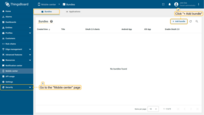
Basic settings
Enter a name for your bundle and select existing Android/iOS apps, or create new ones directly from this window.
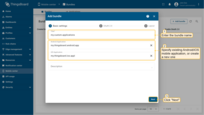
You can add applications even after the bundle with configurations is created.
Create new application
- Click “Create new” in the corresponding section (Android Application or iOS Application).
- Enter the application package name.
- An Application Secret will be generated automatically. Remember it or replace with your own.
- Set the application status:
- Draft: For applications still in development. You can add store information (e.g., Google Play Store or App Store link, and SHA256 certificate fingerprints or App ID) later after the application is created and published.
- Published: For applications that are ready to be launched and used by end users.
- Deprecated: For older applications that are no longer actively supported but still available.
- Suspended: For applications that are temporarily disabled or restricted from use.
- (Optional) Specify minimum/latest app versions and release notes.
- Add store information:
- Android: Google Play Store link and SHA256 certificate fingerprints.
- iOS: App Store link and App ID.
- Click “Add” to save your application and complete the process.

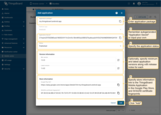

Then, click “Next”.
OAuth 2.0
Add an authentication feature for your users in the ThingsBoard Mobile Application through an external provider that supports the OAuth 2.0 protocol. In order to do this, specify an already configured OAuth 2.0 client(s) or configure a new one. After completing the OAuth 2.0 configuration, click “Next”.
You can also disable the use of OAuth 2.0 for mobile devices.
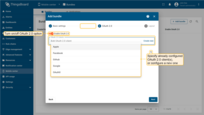
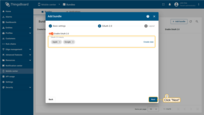
Layout
Set up quick access to the features and dashboards you use most frequently. Add new menu items, change icons and item names, and reorganize the navigation menu of the ThingsBoard Mobile Application according to your needs.
To add new menu item, follow these steps:
- Click the “+ Add specific page” button at the bottom of the page or between existing menu items;
- Enter the name for new menu page;
- Select the page type from the list:
- Dashboard - link to a ThingsBoard dashboard.
- Webview - link to an external webpage.
- Custom - link to built-in ThingsBoard pages.
-
Depending on the selected page type, specify a dashboard, or link to an external webpage or ThingsBoard menu item;
- Click “Add”;
- After configuring layout, click “Add” to complete the bundle creation.
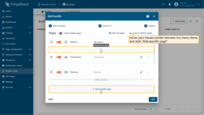
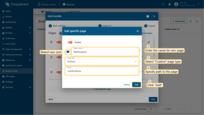
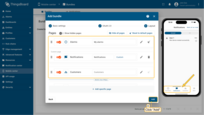
The following routes are available for the “Custom” page type:
| Page name | Routes | Dicription |
|---|---|---|
| Home | /home | Displays the “Home” page |
| Assets | /assets | Displays the “Assets” page |
| Device profiles | /devices | Displays the “Device profiles” page |
| All devices | /deviceList | Displays the list of all devices |
| Alarms | /alarms | Displays the list of alarms |
| Dashboards | /dashboards | Displays the list of dashboards |
| Specific dashboard | /dashboard/:id | Displays the specified dashboard |
| Audit logs | /auditLogs | Displays the “Audit logs” page |
| Customers | /customers | Displays the list of customers |
| Specific customer | /customer/:id | Displays the specified customer |
| Notifications | /notifications | Displays the list of notifications |
| Custom URL link | /url/:link | Displays the “Assets” page |
“More” page
The number of menu items displayed in the navigation menu of the mobile app depends on the screen size of your mobile device. Items that do not fit in the bottom navigation menu will be available under the “More” page.


Configuration dialog
Next, a configuration dialog will open. Continue configuring your new mobile app using the provided instructions. Or skip this step if you already have a ThingsBoard Mobile Application. Click “Close”.
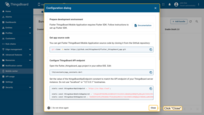
Bundle has been added. The applications specified in the bundle now use the defined settings.
Next steps
-
Getting started guides - These guides provide quick overview of main ThingsBoard features. Designed to be completed in 15-30 minutes.
-
Data visualization - These guides contain instructions on how to configure complex ThingsBoard dashboards.
-
Data processing & actions - Learn how to use ThingsBoard Rule Engine.
-
IoT Data analytics - Learn how to use rule engine to perform basic analytics tasks.
-
Advanced features - Learn about advanced ThingsBoard features.
-
Contribution and Development - Learn about contribution and development in ThingsBoard.


